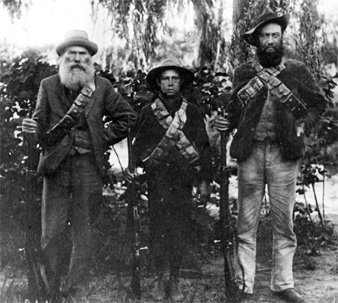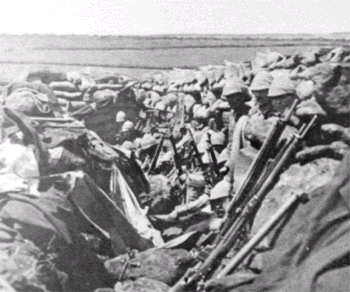
Three generations of Boers

Three generations of Boers
It is possible that James Lewis fought in the 2nd Anglo-Boer war, 1899-1902. Whether he enlisted or was already in the army is open to speculation. His grand daughter, Maureen Watson recalls seeing a collection of memorabilia and booty that he had collected at his home brought back from South Africa. Items such as bullet belts, pistols, medals and pith helmets were on show. There was no conscription in the Boer war, (unlike the first world war where his son Charles Lewis served) which means that either James was in the regular army between those years or volunteered for action, perhaps he was a reservist in the militia or Yeomanry and was called up after the famous 'Black week' when the British army suffered reverse after reverse at the hands of the Boers.

The shape of things to come. Trench life in the Boer War
As the war dragged on it became clear that standard army tactics would not work against the rapidly moving Boers who knew every inch of their territory, either because they had men from the area or they scouted the ground properly, and knew how to use it to their advantage. The Boers would fortify a position on a bluff, plateau or 'Kopje' (hill) often overlooking a river, wait for the British to arrive and await their assault. Weight of numbers and firepower would eventually shift the Boers from their positions but they would simply melt away and reform somewhere else (by pre arrangement) and start all over again. This was very wasteful to the British army as large quantities of men, supplies, ammunition and horses would be expended for little gain. The Boers could also hit the army supply lines and steal their supplies and munitions and use them against the British! Clearly the war would drag on and on if the British generals relied on the tactics that suited the flat open plains of Europe and Salisbury plain rather than the Veldt.
With the attitude of 'if you can't beat 'em join 'em' the army called for a 'Yeomanry' of volunteers, men who could ride a horse and shoot from horseback in the manner of the Boers. Each battalion of regular troops had to equip a platoon as mounted infantry too. This was the only way to meet the Boer on his own terms. Men came from all over the empire particularly Australia, Canada and New Zealand but also many that met this criteria (or said they did) came from England. Many came out of a sense of adventure others to avenge the startling defeat British Arms had suffered in the first Boer war when the British had their noses well and truly bloodied at Majuba Hill. James may have been one of these men. The Boers were highly mobile after generations of fighting this way 'on Commando' and thus could continue the war, although they were heavily outnumbered, against the slow moving foot-sloggers of the British army. James may have been under the command of General Hamilton who excelled in the Anglo-Boer war as a leader of horse but perhaps being a Cavalry officer unsurprisingly failed dismally at the static trenches of Gallipolli. By 1901 both Boer capitals (Bloemfontein and Pretoria) had been taken as well as all their other main towns yet the war still continued as their men were still at large raiding supply depots and trains both sides of the border. Kitchener took charge of field tactics in the later stages of the war and he adopted yet another strategy, to literally deny the Boer commandos food and supplies by:
1) A Scorched earth policy of destroying crops and farmsteads on the veldt.
2) Removing friendly blacks and Boer families off the veldt and into 'concentration' camps where they could be fed and cared for by the British but couldn't grow food for their menfolk. Unfortunately the British did not provide enough suitable camps for the numbers of people they collected off the Veldt which lead to an estimated tenth of the entire Boer population dying in the camps.
3) A system of block houses and barbed wire to reduce Boer manoeuvrability and keep track of their movements. The british built over 8,000 blockhouses across the two states tying down 50,000 british and colonial troops. This was atcatic that dated back to the Roman Republican General Marius' attempts to subdue Jugurtha and his Numidians who relied almost extensively on mounted troops. The Boers too now had to change their tactics and resorted to hit and run guerilla raids.

The proud garrison of a British blockhouse
A particularly brutal order of Kitcheners was that any Boer found wearing British uniform was to be shot. After perhaps months on the veldt and your clothes in rags who wouldn't be tempted to strip a Tommy of his uniform?
James' last son Charles was born in 1900, perhaps James was already on his way to Natal by then? Perhaps he was unaware of his wife's pregnancy. It seems a bit harsh to jaunt off to South Africa leaving either a pregnant wife or a new born baby behind in Birtley. As Charles Lewis was the youngest of the family which would mean that James would still be of an age to be militarily capable in 1900 he would have to be under 45 meaning he would have been born round about 1855-1860. It is from the Boer war that the expression 'Tommy Atkins' to describe a British soldier first appears. The Boers also referred the the British as 'Khakis' (because of their uniforms) or 'Verdomt Rooinekke' (damned rednecks) because they were unused to the blistering hot climate and wore the wrong sort of heavy woollen clothes.
For his part in the Boer war James would have received either the Queens South Africa medal 1899-1901 and/or the Kings South Africa medal 1901-1902 depending on the length of service. He would have recieved a clasp for his part in the relief of Ladysmith. Queen Victoria died in 1901 and was succeeded by Edward VII. By the end of the war some 300,000 British and colonial troops had taken part opposed to some 90,000 Boers.
Click on these links for more info on the Boers and the Boer war:
The South African war virtual Library
From
the Jameson raid to Bloemfontein - Origins of the war
The Boer war remembered
- By Mark Weber
The Boer war museum
The Boer
war battlefields centenary
The Concentration
camps